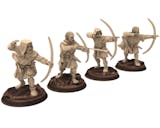Printed in solid non-hollowed resin (no holes).
Good quality resin (40€/kg).
Bases not supplied.
Randomly packaged.
28mm scale (for Saga/Lotr/D&D).
These models were made by Medbury miniatures and are sold under license.
https://www.patreon.com/medburyminiatures/posts
The longbow was a critical weapon in medieval Europe, particularly during the Wars of Scottish Independence and the Hundred Years' War. The English longbowmen, in particular, were famous for their skill and devastating accuracy. Longbows were made from a variety of woods, but yew was considered the best because it was flexible yet strong. The bowstring was made of hemp or flax and was treated with wax to help prevent moisture from weakening it.
In the Wars of Scottish Independence, the longbow was instrumental in the English victory at the Battle of Falkirk. However, it was at the Battle of Bannockburn that the longbow truly shone. Despite being heavily outnumbered, the English army was able to hold off the Scots for several days, largely thanks to the longbowmen who were able to keep the Scottish cavalry at bay with their long-range accuracy. However, the longbow was not just effective against cavalry. At the Battle of Crecy during the Hundred Years' War, the English longbowmen were able to decimate the French knights with their arrows, even piercing their armor.
The longbow required significant skill and strength to use effectively. Archers had to train from a young age and were expected to be able to fire at least ten arrows per minute. The arrows themselves were also specially designed. The bodkin point, for example, was a type of arrowhead that was designed to pierce armor. The longbow was also a relatively cheap weapon to produce, making it accessible to a wider range of soldiers than other weapons like the crossbow.
Despite its effectiveness, the longbow began to lose its importance on the battlefield as firearms became more prevalent. However, the legacy of the longbow continued long after it was no longer in use. In England, for example, archery was made mandatory by law to ensure a steady supply of skilled archers for the military. Even today, archery remains a popular sport, and the longbow continues to be a symbol of medieval warfare and English military prowess.
The longbow has been a key element in many medieval battles, where it was used with great effectiveness. At the Battle of Agincourt in 1415, English archers inflicted heavy losses on the French thanks to their longbows. Similarly, at the Battle of Crecy in 1346, English archers helped decimate the French forces with their longbows and contributed to the English victory. English archers also played a crucial role in the Battle of Poitiers in 1356, where their longbows allowed the English forces to hold their ground against the much larger French forces. In the Battle of Falkirk in 1298, English archers used their longbows with great effectiveness against the Scottish forces. Finally, at the Battle of Courtrai in 1302, Flemish archers used their longbows to inflict heavy losses on the French forces and contribute to the Flemish victory.













